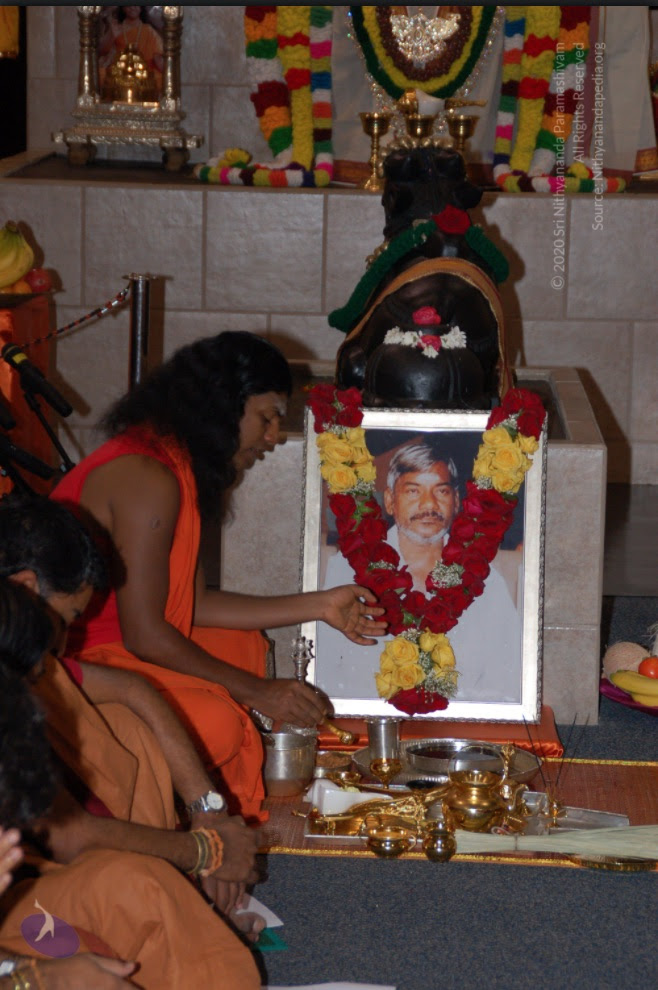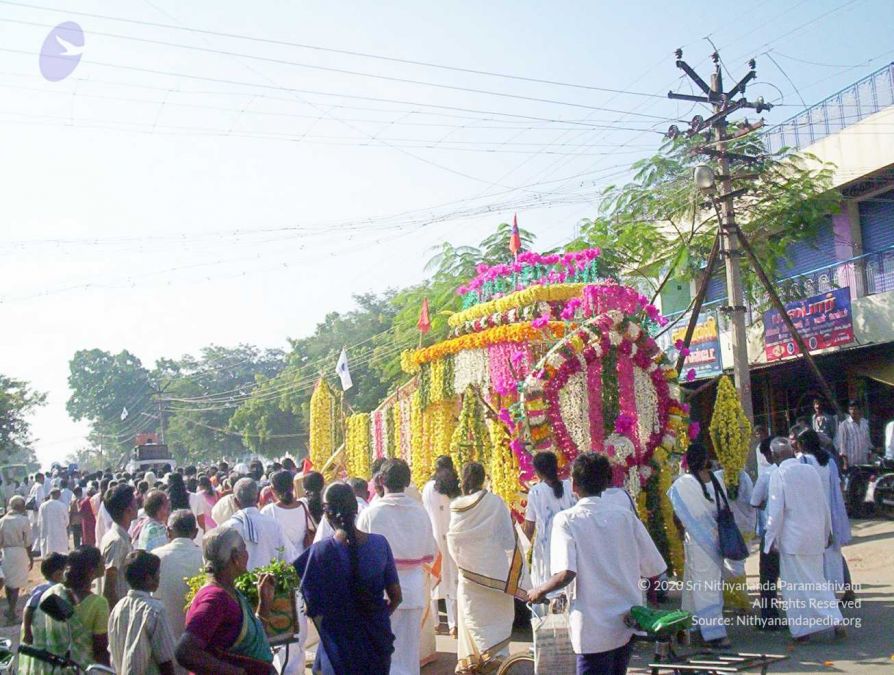
Kailasa’s Mahaparinirvana Day

Mahaparinirvana is observed in KAILASA on Karthika Shukla Dvadashi (Karthika – Lunar month; Shukla Dvadashi – 12th day of the waxing moon). It is the day we offer the shrādha, last rites and pinda tarpana (food offering) to all the initiated disciples of Nithyananda sampradaya (Nithyananda tradition) who left the body; all of them who are residing in KAILASA in salokya mukti with Paramashiva (space where Paramashiva – the Supreme Godhead and Cosmic Principle as per Sanatana Hindu Dharma – resides). They are the disciples who lived with integrity to the Guru, Linga (deity) and Sangha (community). We celebrate by giving Maheshwara puja (ritualistic worship to Paramashiva) to all the sanyasis.
The biological father of The Supreme Pontiff of Hinduism (SPH), Sri Nithya Arunachalananda, also an initiated disciple of The SPH, attained Mahasamadhi on 12 Nov 2005. He attained enlightenment at the Sandhya time (the auspicious twilight time of dawn meeting dusk) and left his body 21 minutes after that. The SPH declared that Nov 12th of every year – the death anniversary of Sri Nithya Arunachalananda, will be celebrated as the Mahaparinirvana Day – day of the Enlightened Souls, in memory of all those who attain Enlightenment and leave the body, with the initiation and grace of The SPH.
Maheshwara Puja is celebrated every year on the Lunar calendar anniversary of 12 Nov 2005, the day Sri Sri Sri Nithya Arunachaleshwarananda attained enlightenment and left the body.

The SPH Bhagawan Sri Nithyananda Paramashivam has declared :
“I myself will be sitting and accepting all the Maheshwara puja and giving shrādha, pinda darpana, pitru darpana (pitru – ancestors) to all the devotees, initiated disciples who left the body. Today is the day My father (Sri Sri Sri Nithya Arunachaleshwarananda) left the body and had the Kailaya pathavi (Place in KAILASA), Shiva pathavi (on 12 Nov 2005).”
Participating in this unique ritual brings completion to us with our past, leading to manifestation of spiritual powers in our life. We then start manifesting what we want, from the Space of Oneness with Paramashiva. Reviving this most ancient ritual of KAILASA as a mainstream ritual for humanity is one amongst The SPH’s unique contributions to re-building a peaceful planet.
Glimpses of Antima Sanyas of Sri Nithya Arunachaleshwarananda Swami – narrated by a disciple present on the occassion
It was the third and final day of the Ashtavakra Gita discourses in Bengaluru. The topic that evening was Enlightenment. Suddenly Ayya (Secretary to SPH), came flying onto the stage. He went behind the sofa and whispered something to Him. The SPH covered the mic with his one hand, listened calmly to Ayya and made a facial gesture that seemed to convey, ‘I’ll take care.’ Ayya came and said, “Amma, The SPH Nithyananda Paramashivam’s father has attained mahasamadhi (final liberation). All of us are leaving for Tiruvannamalai as soon as Swamiji finishes. Please round up all acharyas (teachers) and healers and gather them at one place. At no point should your body language reveal what I have just now conveyed to you. Swamiji wants you to remain calm and act with spiritual maturity.” Then Swamiji blessed each and everyone in the queue taking as much time as he would in the normal course of events.
When we reached Tiruvannamalai Swamiji addressed us, ‘Go inside. Pay respects. Be with my mother. See to it that no one disturbs her. I don’t want anyone wailing and weeping and creating scenes.” I found the atmosphere to be strange. I couldn’t put my finger on it. Then it suddenly dawned on me that no one was crying! Everyone sat quietly. I had witnessed many deaths in my family. The ambience had always been one of great grief. Wailing, shouting and calling out to the departed is the rule rather than the exception. We sat around Amma (SPH’s mother) who was an inspiration to watch. There was an air of innocence and dignity in her demeanor. She aligned her wishes to her son and her Guru . She exhibited a total childlike trust in Him. As she simply and beautifully put it: ‘Swami ennodu irrukumpodu vera enna ma ennakku venum? Avar ellamay patthuparu, ma.’ (When Swamiji Himself is with me, what more can I ask for? He will take care of everything, ma.) She showed a high level of spiritual maturity that is rare for a person, especially a woman born and brought up in a small, closed society.
The SPH Says…
I have blessed him with the ultimate gift of enlightenment. His energy will never again be converted to matter. He has left his body smoothly, without pain. He is relaxed and relating with me. “Amma, nee kavalai padadhey, naa pathikirain.” (Amma, you don’t worry. I will take care.) So saying, Swamiji stood up, walked to the glass coffin and very lovingly, with a beautiful smile on his face, blessed his father’s body.
Swamiji was living the truths that He had spoken of on so many occasions, in all those meditation programs. Swamiji showed us the way to receive death, the way to handle the dead and the living. No book can give this understanding, this kind of confidence. I understood why Swamiji was particularly careful to maintaining a deeply joyous atmosphere.
SPH explained, ‘When Ayya came up on stage and informed me that my father was no more, I paused awhile and related to his energy.
I clearly saw that before his death, my father had gone into an enlightened state and had stayed there for at least 21 minutes. He had attained mahasamadhi, the great liberation. Then he had relaxed beautifully into the all-pervading consciousness.
I told Ayya to relax and carry on with the necessary arrangements. In those few moments of relating, I did whatever had to be done at the initial stage for the soul to move on. I had to take care of the people who had come for my blessings at the discourse. They too need me.” In those few moments, the teachings of Ashtavakra – you are by your nature unattached, renounced, liberated; you are the all-pervading, witnessing consciousness – had been expressed through Swamiji’s sheer body language.
Here, before our eyes was a living example. Masters do not teach. Their life is their teaching. If you are alert and awake around the master, you can learn within moments what years of poring over great philosophies cannot teach you.
…when the soul leaves the body it is essential that the atmosphere is light, suffused with spiritual understanding, awareness, and a mood of deep celebration. Then we make it easier for the soul to move on smoothly to the next dimension. This is the greatest gift of love we can give to anyone. This is the ultimate act of selflessness.
The ritual of singing, dancing and rejoicing is a major part of all Maheshwara Puja when celebrated in Kailasa.
On this special, auspicious day of Mahaparinirvana Day, SPH has declared that all initiated disciples who lived with integrity to Guru, Linga and Sangha are liberated.
Why was Swamiji insistent that no one should weep and wail? As far as my understanding goes, when the soul leaves the body it is essential that the atmosphere is light, suffused with spiritual understanding, awareness, and a mood of deep celebration. Then we make it easier for the soul to move on smoothly to the next dimension. This is the greatest gift of love we can give to anyone. This is the ultimate act of selflessness. When we cry, when we grieve, we create such a heavy atmosphere that the soul struggles to leave. We cause an obstruction. This is the greatest act of cruelty that we can commit. Our energies, instead of being tight and confined to our boundaries through fear and grief, were expanding and relating to the high level of enlightened energy present in the room.
The moment of death can be a process of deep alchemy for the dying and the living. Since this blessed soul had attained samadhi, the energy it radiated, combined with the powerful vibrations of an enlightened master’s presence, had the power to transform all those tuned to it. This was exactly what Swamiji was working on. I noticed that there had not been any change in the physical condition of the body. Death had arrived on 12th evening and now it was 14th morning. The body was as intact as it had been on the first day that we had seen it. No doubt it was kept on ice; yet not a single change had happened, considering the low level of sophistication of that glass coffin and the heat of Tiruvannamalai. The face radiated the same sereneness; there was no odor of decay. The use of agarbattis (incense sticks) and room fresheners had stopped long ago.
The next moments were all about history being created in Tiruvannamalai. For the first time women were allowed to accompany the funeral procession to the cremation area. The most poignant and unbelieving scene was that of Amma, the wife of the departed soul, walking alongside the vehicle, rhythmically clapping her hands to the beat of the devotional song. What astonishing courage.
Swamiji informed the gathered crowd that as a sannyasi who had cut all family ties, He couldn’t perform the last rites of his father as a son would traditionally be expected to do. However as a guru, it was His responsibility to conduct the rites of passage for His disciple. Swamiji recalled that when He had asked His father what kind of help he needed, His father had answered simply: ‘Swami irunda podum.’ (If You are there, that is enough) Swamiji told us, “At that moment, He became my disciple. That complete, total trust is enough. Nothing else is needed.” As Swamiji’s father’s energy had traveled directly from a conscious state to a superconscious one, without slipping into the unconscious coma state, and had remained in that exalted level for 21 minutes, he had become enlightened.

The SPH performed all the final rituals as is to be done for enlightened souls. The SPH gave Anthima Sannyas as per the Hindu tradition to His biological father as part of the final ceremony, since His father attained Enlightenment before leaving the body.
In Hindu civilization there are many references of how an Avatar, an Incarnation has liberated and enlightened a being & given them Antima Sannyas after they leave the body. One such reference is from the life of Adishankaracharya. Adishankaracharya gave Antima Sannyas to his pre-monastic mother while performing her last rites & liberating her.

